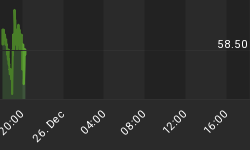It has to happen, I suppose. One final inflationary blow-off to scare everyone into thinking that a 1970s-type inflationary environment is coming upon us once again. This will most likely be the final move up in the 2003-2004 war-time inflationary market for inflation-sensitive commodities such as oil (intermediate-term, at least). Until this inflationary trend ends the stock market will have a very difficult time getting going. But based on my analysis it should end very soon, probably with the 10-year cycle bottom. By later this month I believe we'll see stock prices on the rise and commodity prices on the wane, particularly crude oil.
It's all about the crude oil price right now on Wall Street, as you are well aware. You can't even turn on CNBC or other financial news channels without seeing the oil ticker somewhere on the screen at all times.
Here are the latest headlines from the Financial Times concerning oil that I've clipped just in the past 2-3 days alone; i.e., my latest "fear collage." These headlines show an acceleration in fear related to the crude oil price trend and tell us that the extended oil rally of 2004 is nearing its finale:
"Increased oil price forces IMF to cut its forecast -- Fund warns world economic growth threatened," "Oil price breaks the $50 barrier," "Supply concerns push crude oil to fresh highs," "Energy costs have Wall Street worried," "Fears over oil supply push price to new high," "Threats to Nigerian installations add to worries," "G7 says high oil prices a risk to global economy."
My latest assessment of the crude oil chart shows that the final upside blow-off is now underway. Considering that crude is already above its previous high, any further gains in the price of oil in coming days will only serve to spook the stock market bears even more, thus setting up an even more conducive psychological backdrop for the fourth quarter equity market boom. By the end of this year I predict that crude will revisit the $40 level regardless of how high it spikes between now and one week from now.
What about the gold price? Gold still has upside momentum in its favor and is above its rising 30/60/90-day moving averages. In fact, it is just about to run up against its parabolic up-curve, which should produce another impressive rally.
As an aside, I'd like to point out that there is most definitely a correlation between economic cycles and weather/earth cycles based on my studies. I've observed this interrelation -- this cosmology of cyclical influences if you will -- for years and I'm more convinced than ever that it exists. Is it any coincidence that the U.S. has had its worst storm season in a long time in 2004, the year of the 10-year cycle bottom? (Though perhaps it is a coincidence that there were *10* tropical storms along the southeastern coast this year!)
Now there is the renewed threat of the volcanic eruption of Mt. Saint Helens, which erupted in a major fashion in 1980 -- the year of the previous inflationary blow-off! Another coincidence? Perhaps, but I don't believe so.
One "inflationary trend" that will continue into 2005 is the continued rise of home values and real estate prices. The real estate bull market is still in the "sweet spot" of its uptrend and this will most likely continue into 2005. In fact, 2005 could be a banner year for U.S. real estate, eclipsing anything we've seen so far in this young decade.
As previous mentioned in my article entitled "Can the real estate boom continue?", the Morgan Stanley REIT index (RMS) has already achieved my conservative 680 upside target and will now look to test the 700 level in the next couple of weeks. This is a very strong-looking chart, as you can see.

After tracing out three waves to the downside this year (that's an "a-b-c correction" for you Elliott Wave fans), the NASDAQ Composite index not only achieved our upside target of 1950 on Monday but it exceeded it. The NASDAQ has broken above its 1925 resistance level and has closed two consecutive days above its 90-day moving average. This is what's called a "pivotal breakout" and it means the NASDAQ has seen its lows for this year. It also establishes a new uptrend for the NASDAQ. The index will most likely lead the broad market higher as we head into the fourth quarter.
















